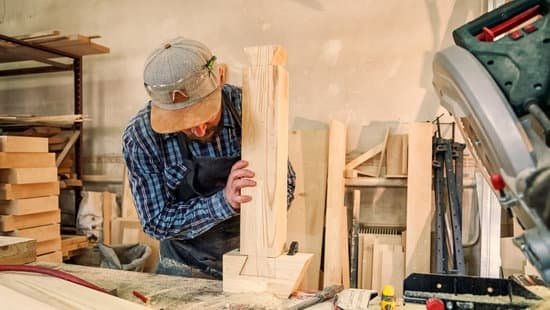Are you interested in woodworking and want to learn how to work a woodworking biscuit machine? This article will provide you with an in-depth guide on understanding, operating, and maintaining this essential tool for woodworking projects.
A woodworking biscuit machine, also known as a plate joiner, is a versatile and efficient tool used to join wood pieces together. Whether you are a beginner or an experienced woodworker, knowing how to effectively operate a woodworking biscuit machine is crucial for achieving precise and strong joints in your projects.
Understanding the parts of the woodworking biscuit machine is essential before using it. In this article, we will provide you with detailed explanations of each part and its function. Visual aids and diagrams will also be included to help you better understand how the machine works.
Additionally, safety precautions when working with a woodworking biscuit machine cannot be overstated. We will discuss the importance of using safety goggles, gloves, and other safety equipment, as well as provide tips for avoiding accidents and injuries while using the machine.
Choosing the right biscuits for your project is another important aspect that will be covered in this article. You’ll learn about the different types and sizes of biscuits available and which ones are suitable for various woodworking applications.
Our tips for selecting the appropriate biscuits for a specific project will help you achieve strong and durable joints in your woodworking projects. Stay tuned as we delve into setting up, operating, maintaining, and even getting creative with your woodworking biscuit machine.
Understanding the Parts of the Woodworking Biscuit Machine
The parts of a woodworking biscuit machine are essential to understand before using the machine for any woodworking project. Each part plays a crucial role in ensuring accurate and precise biscuit cuts. Here is a detailed explanation of the parts and their functions:
1. Fence: The fence is a flat, vertical surface that provides support and stability for the workpiece during cutting. It ensures that the workpiece remains in the correct position while the biscuit slots are being created.
2. Depth Stop: The depth stop allows users to adjust the cutting depth of the biscuit slots. It is important to set the depth correctly based on the size of the biscuits being used and the thickness of the workpiece.
3. Blade: The blade, also known as a cutter, is responsible for creating the biscuit slots in the wood. It is essential to ensure that the blade is sharp and properly aligned for clean and accurate cuts.
4. Height Adjustment Knob: This knob allows users to adjust the height of the blade according to the thickness of the workpiece. Proper height adjustment is crucial for achieving precise biscuit cuts.
5. Dust Port: The dust port is designed to connect to a dust collection system or vacuum, helping to keep your workspace clean by capturing sawdust and debris during operation.
Understanding how each part of a woodworking biscuit machine functions is key to operating it safely and effectively. Visual aids, diagrams, or even tutorial videos can be beneficial tools for those learning how to work with this type of machinery.
Safety Precautions When Working With a Woodworking Biscuit Machine
When working with a woodworking biscuit machine, it is crucial to prioritize safety to avoid accidents and injuries. One of the most important safety precautions is wearing appropriate protective gear. This includes safety goggles to protect your eyes from flying debris, as well as gloves to protect your hands from sharp edges and potential cuts. Additionally, it is essential to wear hearing protection, especially during prolonged use of the machine, as it can generate loud noise levels.
It is also important to keep the work area clean and free from obstructions. This helps prevent tripping hazards and ensures that you have ample space to maneuver around the biscuit machine safely. Always inspect the machine for any issues before starting your project, and never operate it if there are any visible damages or malfunctions.
Lastly, follow all the manufacturer’s recommended safety guidelines and operating procedures when using the woodworking biscuit machine. These guidelines are designed to keep you safe while using the equipment and should not be overlooked.
| Safety Precautions | Importance |
|---|---|
| Wearing protective gear | Essential for preventing injuries from flying debris or sharp edges |
| Clean work area | Prevents tripping hazards and ensures maneuverability |
| Following manufacturer’s guidelines | Crucial for safe operation of the woodworking biscuit machine |
Choosing the Right Biscuits for the Project
When choosing the right biscuits for your woodworking project, it is important to consider the type and size of the biscuits that will work best for the task at hand. Biscuits come in different materials such as beechwood and metal, and they also vary in size from #0 to #20.
The choice of biscuit will have an impact on the strength and alignment of the joint. For example, smaller biscuits are suitable for thinner stock or narrow components, while larger biscuits provide more strength for larger pieces.
It’s essential to select the appropriate biscuits based on the specific requirements of your project. For instance, if you are working on a delicate piece of furniture that requires precision and a concealed joint, a smaller biscuit would be ideal. On the other hand, if you are constructing a sturdy table or cabinet that needs additional reinforcement, a larger, heavy-duty biscuit would be more suitable.
| Biscuit Type | Strength | Alignment |
|---|---|---|
| Wooden Biscuits | Less strength | Better alignment due to wood swelling with glue |
| Metal Biscuits | More strength | Precise alignment due to uniform size and shape |
To choose the right biscuits for your woodworking project, consider factors such as wood type, thickness of material, desired joint strength, and final appearance. Once you have assessed these factors, you can confidently select the most appropriate biscuits for your specific application. By understanding how to choose the right biscuits for your project, you can achieve strong and aesthetically pleasing joints in your woodworking creations.
Setting Up the Woodworking Biscuit Machine
When it comes to working with a woodworking biscuit machine, proper setup is crucial for achieving precise and accurate biscuit cuts. Whether you are a beginner or an experienced woodworker, understanding how to set up the machine is essential for successful joinery projects.
Step-by-Step Guide
To begin setting up the woodworking biscuit machine, start by carefully reading the manufacturer’s instructions and familiarizing yourself with the various parts of the machine. Ensure that all necessary components such as fences, stops, and dust collection systems are included and properly assembled. After assembling the machine, adjust the height, angle, and depth settings according to your specific project requirements.
Next, make sure that the blade or cutter is sharp and in good condition. Dull blades can result in uneven biscuit cuts and may compromise the overall quality of your woodworking project. Additionally, ensure that the power source is connected properly and that all safety features such as emergency shutoff switches are in place and functioning correctly.
Troubleshooting Common Setup Issues
Even with proper setup procedures in place, woodworkers may encounter common issues when preparing their biscuit machines for operation. Some typical problems include misaligned fences or stops, inaccurate depth settings, or difficulty with securing workpieces in place.
To address these issues, carefully inspect each component of the woodworking biscuit machine to identify any misalignments or malfunctions. Adjusting fence positions, tightening screws and bolts, or replacing worn-out parts can help resolve setup issues. It’s also important to double-check all measurements before making any cuts to ensure precision in your joinery work.
By following these step-by-step guidelines for setting up a woodworking biscuit machine and addressing common setup issues proactively, woodworkers can effectively prepare their equipment for smooth operation when working on various joinery projects.
Overall, whenever setting up this type of machinery it’s crucial follows these protocols.
Operating the Woodworking Biscuit Machine
Once you have safely set up your woodworking biscuit machine, it’s time to learn how to effectively operate it. Follow these steps to ensure precise and accurate biscuit cuts for your woodworking projects:
1. Adjust the Depth: Before starting, make sure to adjust the depth of the cutting blade according to the size of biscuit and the wood material being used. This will ensure that the biscuits fit snugly into the slots without protruding from the surface.
2. Positioning: Place the wood pieces on a stable work surface and position them so that the biscuits will create a strong joint. Take your time to align them properly before making any cuts.
3. Cutting: Turn on the machine and slowly lower the cutting blade onto the wood piece, taking care to maintain a steady hand throughout. Start by making one cut in each piece of wood to accommodate the biscuit.
4. Test Fits: After cutting slots in both pieces of wood, dry-fit them together with a biscuit inserted in each slot. This will allow you to check for any discrepancies in fit and make adjustments if necessary.
5. Gluing: Once you are satisfied with how everything fits together, apply woodworking glue inside each slot and along the edges of each biscuit before assembling everything together smoothly.
By following these steps, you can effectively utilize your woodworking biscuit machine to create strong and seamless joints in your woodworking projects.
Maintenance and Care of the Woodworking Biscuit Machine
Importance of Regular Maintenance
Proper maintenance of a woodworking biscuit machine is crucial to ensure its longevity and performance. Regular maintenance helps prevent malfunctions, extends the machine’s lifespan, and ensures safety during operation. Neglecting maintenance can lead to costly repairs and potential safety hazards. By following a routine maintenance schedule, woodworkers can keep their woodworking biscuit machine in optimal condition.
Cleaning and Lubrication Tips
One of the key aspects of maintaining a woodworking biscuit machine is keeping it clean and properly lubricated. After each use, it is important to thoroughly clean the machine to remove sawdust, debris, and any residual adhesive from the biscuits. This helps prevent build-up that can affect the machine’s accuracy and performance over time. Additionally, regular lubrication of moving parts such as the fence, blade, and depth adjustment mechanisms is essential to keep the machine running smoothly.
Troubleshooting Common Issues
In addition to regular maintenance, woodworkers should be familiar with troubleshooting common issues that may arise with their woodworking biscuit machine. This includes addressing problems such as inaccurate cuts, motor overheating, or difficulties in adjusting settings. Understanding how to identify and resolve these issues can help maintain the machine’s efficiency and save time during woodworking projects.
By following these maintenance and care guidelines, woodworkers can ensure that their woodworking biscuit machine remains in top condition for years to come. Regular cleaning, lubrication, and troubleshooting will not only prolong the life of the machine but also contribute to achieving precise and high-quality results in woodworking projects.
Creative Applications of a Woodworking Biscuit Machine
In conclusion, understanding how to work a woodworking biscuit machine is essential for anyone involved in woodworking projects. Whether you are a professional carpenter or a hobbyist, the ability to use this machine effectively can greatly enhance the quality and strength of your woodworking creations. From joining pieces of wood together to creating unique and intricate designs, the creative applications of a woodworking biscuit machine are endless.
By following the detailed instructions provided in this article, individuals can gain a comprehensive understanding of how to operate a woodworking biscuit machine with confidence and precision. From choosing the right biscuits for the project to setting up and maintaining the machine, every aspect has been covered in depth. Additionally, safety precautions when working with this machinery have been highlighted to ensure that users prioritize their well-being at all times.
Furthermore, the examples of projects that can be accomplished with a woodworking biscuit machine serve as inspiration for readers to explore their creativity and experiment with different woodworking techniques. By incorporating biscuit joinery into their projects, individuals have the opportunity to elevate their woodworking skills and produce high-quality, professional-looking results. With the knowledge gained from this article, readers can confidently embark on their woodworking endeavors with newfound expertise on how to work a woodworking biscuit machine.
Frequently Asked Questions
How Do You Use Biscuits in Woodworking?
Biscuits are used in woodworking to create strong and seamless joints between two pieces of wood. The biscuit joiner tool is used to cut matching slots in the pieces of wood that will be joined together, and then a football-shaped wooden biscuit is inserted into these slots along with glue.
When the glue dries, the biscuits expand, creating a tight bond between the two pieces of wood.
Are Biscuit Joiners Worth It?
Whether biscuit joiners are worth it depends on the frequency of your woodworking projects and the types of joints you typically work with. For professionals or serious hobbyists who frequently work with large panels or need strong joints, a biscuit joiner can be worth the investment.
However, for occasional or small-scale woodworking projects, there may be other methods of joining wood that are more cost-effective.
How Do You Use a Craftsman Biscuit Joiner?
To use a Craftsman biscuit joiner, start by adjusting the cutting depth to match the size of biscuit you will be using. Then, mark out where you want to make cuts on both pieces of wood being joined. With the tool turned off, align it with your markings and clamp it securely in place.
Turn on the biscuit joiner and plunge it into each marked area to create slots for the biscuits. Finally, add glue to the slots and insert the biscuits before joining the pieces of wood together.

Hi everyone! I’m a woodworker and blogger, and this is my woodworking blog. In my blog, I share tips and tricks for woodworkers of all skill levels, as well as project ideas that you can try yourself.





